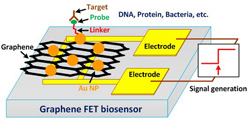Crossref Citations
This article has been cited by the following publications. This list is generated based on data provided by
Crossref.
Mao, Shun
Chang, Jingbo
Pu, Haihui
Lu, Ganhua
He, Qiyuan
Zhang, Hua
and
Chen, Junhong
2017.
Two-dimensional nanomaterial-based field-effect transistors for chemical and biological sensing.
Chemical Society Reviews,
Vol. 46,
Issue. 22,
p.
6872.
Hashima, Yuki
Ishikawa, Yasuaki
Raifuku, Itaru
Inoue, Ippei
Okamoto, Naofumi
Yamashita, Ichiro
Minami, Tsuyoshi
and
Uraoka, Yukiharu
2018.
Easy and green preparation of a graphene–TiO2 nanohybrid using a supramolecular biomaterial consisting of artificially bifunctionalized proteins and its application for a perovskite solar cell.
Nanoscale,
Vol. 10,
Issue. 41,
p.
19249.
Ghosh, Sujoy
Khan, Niazul I.
Tsavalas, John G.
and
Song, Edward
2018.
Selective Detection of Lysozyme Biomarker Utilizing Large Area Chemical Vapor Deposition-Grown Graphene-Based Field-Effect Transistor.
Frontiers in Bioengineering and Biotechnology,
Vol. 6,
Issue. ,
Chen, Xiaoyan
Zhou, Guihua
Mao, Shun
and
Chen, Junhong
2018.
Rapid detection of nutrients with electronic sensors: a review.
Environmental Science: Nano,
Vol. 5,
Issue. 4,
p.
837.
Cortijo-Campos, Sandra
Álvarez-Fraga, Leo
Gonçalves, Gil
Vila, Mercedes
Álvarez, Patricia
Menéndez, Rosa
de Andrés, Alicia
and
Prieto, Carlos
2019.
In-situ carboxylation of graphene by chemical vapor deposition growth for biosensing.
Carbon,
Vol. 141,
Issue. ,
p.
719.
Liu, Chengbin
Chen, Xiaoyan
Zong, Boyang
and
Mao, Shun
2019.
Recent advances in sensitive and rapid mercury determination with graphene-based sensors.
Journal of Materials Chemistry A,
Vol. 7,
Issue. 12,
p.
6616.
Salehnia, Foad
Fakhri, Neda
Hosseini, Morteza
Ganjali, Mohammad Reza
and
Ganjali, Mohammad Reza
2019.
Handbook of Graphene.
p.
535.
Ruiz-Calleja, Tamara
Bonet-Aracil, Marilés
Gisbert-Payá, Jaime
and
Bou-Belda, Eva
2020.
Analysis of the influence of graphene and phase change microcapsules on thermal behavior of cellulosic fabrics.
Materials Today Communications,
Vol. 25,
Issue. ,
p.
101557.
Schuck, Ariadna
Kim, Hyo Eun
Jung, Kyung-Mo
Hasenkamp, Willyan
and
Kim, Yong-Sang
2020.
Monitoring the hemostasis process through the electrical characteristics of a graphene-based field-effect transistor.
Biosensors and Bioelectronics,
Vol. 157,
Issue. ,
p.
112167.
Khan, Niazul I.
and
Song, Edward
2020.
Lab-on-a-Chip Systems for Aptamer-Based Biosensing.
Micromachines,
Vol. 11,
Issue. 2,
p.
220.
Fernández, Ana C. Rossi
and
Castellani, Norberto J.
2020.
Dipole moment effects in dopamine/N-doped-graphene systems.
Surface Science,
Vol. 693,
Issue. ,
p.
121546.
Yang, Lei
Jin, Yuqing
Wang, Xuejun
Yu, Bin
Chen, Renzhong
Zhang, Cong
Zhao, Yan
Yu, Yuguo
Liu, Yunqi
and
Wei, Dacheng
2020.
Antifouling Field‐Effect Transistor Sensing Interface Based on Covalent Organic Frameworks.
Advanced Electronic Materials,
Vol. 6,
Issue. 5,
Kaur, Lovleen
Mahendia, Suman
Saini, Sangeeta
and
Srivastava, Anurag
2021.
Arsenic sensing using Al/Fe doped armchair graphene nanoribbons: Theoretical investigations.
Journal of Physics and Chemistry of Solids,
Vol. 152,
Issue. ,
p.
109975.
Liang, Bor-Wei
Chang, Wen-Hao
Lin, Hung-Yu
Chen, Po-Chun
Zhang, Yi-Tang
Simbulan, Kristan Bryan
Li, Kai-Shin
Chen, Jyun-Hong
Kuan, Chieh-Hsiung
and
Lan, Yann-Wen
2021.
High-Frequency Graphene Base Hot-Electron Transistor.
ACS Nano,
Vol. 15,
Issue. 4,
p.
6756.
Schuck, Ariadna
Kim, Hyo Eun
Moreira, Júlia Konzen
Lora, Priscila Schmidt
and
Kim, Yong-Sang
2021.
A Graphene-Based Enzymatic Biosensor Using a Common-Gate Field-Effect Transistor for L-Lactic Acid Detection in Blood Plasma Samples.
Sensors,
Vol. 21,
Issue. 5,
p.
1852.
Johnson, Asha P.
Sabu, Chinnu
Swamy, N. Kumara
Anto, Annstephy
Gangadharappa, H.V.
and
Pramod, K.
2021.
Graphene nanoribbon: An emerging and efficient flat molecular platform for advanced biosensing.
Biosensors and Bioelectronics,
Vol. 184,
Issue. ,
p.
113245.
Sawkar, Rakesh R.
Shanbhag, Mahesh M.
Tuwar, Suresh M.
Mondal, Kunal
and
Shetti, Nagaraj P.
2022.
Zinc Oxide–Graphene Nanocomposite-Based Sensor for the Electrochemical Determination of Cetirizine.
Catalysts,
Vol. 12,
Issue. 10,
p.
1166.
Zhang, Xue
Liao, Xiaoning
Wu, Yongfa
Xiong, Wanming
Du, Juan
Tu, Zhui
Yang, Wuying
and
Wang, Dan
2022.
A sensitive electrochemical immunosensing interface for label-free detection of aflatoxin B1 by attachment of nanobody to MWCNTs-COOH@black phosphorene.
Analytical and Bioanalytical Chemistry,
Vol. 414,
Issue. 2,
p.
1129.
Sarker, Biddut K.
Hampton, Cheri M.
and
Drummy, Lawrence F.
2023.
Graphene Field‐Effect Transistors.
p.
339.
Kumar Ganechary, Pavan
Gupta, Tanisha
and
Shekhar Yadav, Chandra
2023.
Development of nanomaterial based biosensors for forensic applications.
Materials Today: Proceedings,
Vol. 95,
Issue. ,
p.
88.




